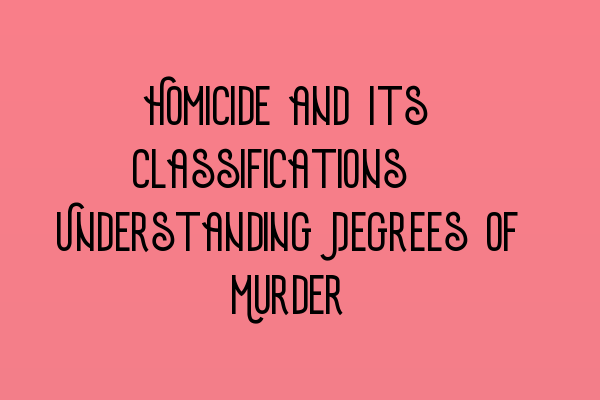Homicide and Its Classifications: Understanding Degrees of Murder
When it comes to criminal law, understanding the different degrees of murder is crucial. Homicide, the act of unlawfully causing another person’s death, can be classified into various degrees depending on the intent and circumstances surrounding the crime. In this article, we will delve into the different classifications of homicide and shed light on their legal implications.
Murder in the First Degree
Murder in the first degree is the most serious form of homicide, carrying the highest penalties. It typically involves premeditation and a deliberate intent to cause death. Cases falling under this category often include planned murders, assassinations, or murders committed during the commission of another crime like robbery or kidnapping.
If you want to learn more about the Solicitors Qualifying Examination format, you can check out our related article on Demystifying the Solicitors Qualifying Examination Format.
Murder in the Second Degree
Murder in the second degree is characterized by a lesser degree of intent compared to first-degree murder. While it may still involve malice aforethought, this classification often refers to killings that lack premeditation or occur in the heat of the moment. Examples include impulsive acts of violence or unplanned homicides that happen during arguments or altercations.
If you’re an aspiring UK entrepreneur interested in LLC formation, our step-by-step guide on LLC Formation Made Simple: Step-by-Step Guide for UK Entrepreneurs will provide you with valuable insights.
Manslaughter
Manslaughter refers to the unlawful killing of another person without malice aforethought. Unlike murder, manslaughter doesn’t involve the intention to cause the victim’s death. Instead, it often arises from a momentary lapse of judgment, reckless behavior, or the unintentional result of a lawful act. Manslaughter can be further divided into voluntary and involuntary categories.
Voluntary Manslaughter
Voluntary manslaughter occurs when a person intentionally causes another person’s death but under circumstances that mitigate the severity of the act. These circumstances often include extreme provocation, heat of passion, or diminished mental capacity. However, voluntary manslaughter still holds serious legal consequences.
If you want to get a comprehensive overview of business regulations in the UK, we recommend reading our article on Business Regulations in the UK: A Comprehensive Overview.
Involuntary Manslaughter
Involuntary manslaughter refers to unintentional killings resulting from reckless or negligent behavior. It is often associated with actions that disregard the safety of others, such as drunk driving, medical malpractice, or other negligent acts. While the absence of intent distinguishes it from murder, involuntary manslaughter is still a serious offense.
If you’re preparing for the SQE exam, our article on Preparing for the SQE Exam: Strategies and Resources for Success can provide you with valuable tips and resources.
Conclusion
Understanding the classifications of homicide is vital for both legal professionals and the general public. The varying degrees of murder help determine appropriate charges and sentencing in criminal cases. From premeditated first-degree murder to involuntary manslaughter, each category represents distinct levels of intent and culpability. By familiarizing ourselves with these classifications, we can navigate the complex world of criminal law with greater clarity and understanding.
If you’re looking to accelerate your exam preparation, our SQE workshops and webinars can provide you with an edge. Learn more by visiting our article on SQE Workshops and Webinars: Accelerate Your Exam Preparation.
